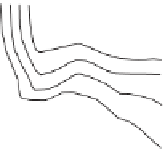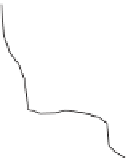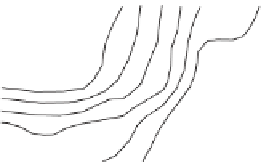Geoscience Reference
In-Depth Information
(a)
8
4
0
(b)
1.2
0.8
0.4
0
(c)
0
10
33.2
34.2
20
0600
1000
1400
1800
Time
Figure 9.18
Response of primary producers to semi-diurnal changes in stratification in
Liverpool Bay, UK. (a) Uptake rates of urea-nitrogen for autotrophic (
○
) and heterotrophic
(
●
) phytoplankton at a depth of 10 metres. (b) Concentration of urea-nitrogen at a depth of
10 metres. (c) Time-depth series of changes in salinity. Times are BST (UTC
þ
1 hour) on
May 4, 1977. High water was at 1230 BST and it was a spring tide. Based on Floodgate et al.,
1981,
with permission from Nature.
Originally these data were interpreted in terms of the tidal advection of a front back
analysis of the salinity changes suggested that, rather than advection of a front, the
cycle of stratification and mixing was being driven by tidal straining (Simpson et al.,
1991
). The data in
Fig. 9.18
could indicate that the phytoplankton nutrient uptake
(and potentially growth) was responding to the straining-induced changes in stratifi-
cation. Alternatively, while a front may not have been a consistent feature of the
region, horizontal patchiness in urea uptake could have been advected past the
research vessel. In Problem 9.3 you can think about how you might interpret
the data in
Fig. 9.18
, and what additional data you would collect, in order to decide















































































Search WWH ::

Custom Search